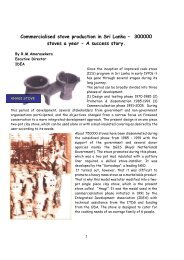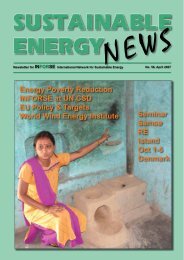Improved Cook Stove (ICS) Development: A Case from Nepal
Improved Cook Stove (ICS) Development: A Case from Nepal
Improved Cook Stove (ICS) Development: A Case from Nepal
Create successful ePaper yourself
Turn your PDF publications into a flip-book with our unique Google optimized e-Paper software.
promoters are trained in all the aspects of <strong>ICS</strong> installation and monitoring, enhancing their economicopportunities. In some cases, <strong>ICS</strong> construction has been the major source of income generation. Thesustainability of <strong>ICS</strong> has also been enhanced as these local promoters are responsible for regular monitoringof the performance of the stove.• The emphasis given on monitoring and evaluation has been very crucial for the sustainability and success ofthe program.• In addition to <strong>ICS</strong> installation, the National <strong>ICS</strong> program has been promoting the concept of kitchenmanagement. Improving the overall kitchen environment is essential to have a broader impact on the life,especially of women. The concept of kitchen management includes improved kitchen ventilation, overallmanagement of kitchen wares, maintaining hygiene, waste-water drainage systems and waste management.The concept of kitchen mangament is thus increasing the kitchen efficiency as well as reducing hardship ofwomen.Problems and Solutions:<strong>ICS</strong> is a simple technology based on scientific concepts and easy to operate. Users donot face any severe technical problems during its operation. The problems may arise if<strong>ICS</strong> promoters do not adhere to the technical specification during installation or if usersneglect regular maintenance.In the <strong>Nepal</strong>i context, users clean the cook stove and plaster with the mud daily. Thistends to change the pothole size and decrease the efficiency of stoves. Some of thetypical problems encountered in the stoves are smoke backfiring because of wrongplacement of chimney outlet, lack of regular cleaning of the chimney and slow cookingin the second pothole. However, the promoters always provide orientation on probableproblems and their solution to the users. Users are also provided with the manual onoperation and maintenance of the stove. Moreover, promoters regularly monitor the operation, check stovesefficiency and solve remaining problem.Progress Status:From its initiation in May 1999 to the end of June 2005, the National <strong>ICS</strong> Program has disseminated about125,000 <strong>ICS</strong> serving the same number of households in 33 mid-hill districts. The combined effort of national <strong>ICS</strong>Program and other organizations led to a dissemination of 200,000 <strong>ICS</strong> in the country by the end of June 2005.One should remember, however, that it remains a meager number compared with the 2 million wood-burninghouseholds located in the rural areas.The National <strong>ICS</strong> Program exemplifies the success of <strong>ICS</strong> dissemination program. The lessons learned <strong>from</strong> thisprogram can be incorporated in other programs:• Demand generation <strong>from</strong> the community members themselves is very important for acceptance of thetechnology and its sustainability. This can only be achieved through effective information campaigns andawareness-development activities.• Involvement of local organizations in <strong>ICS</strong> dissemination and their building-capacity is essential for massscale-up of <strong>ICS</strong> without too much external supports.• <strong>Development</strong> of technical service providers or promoters at local level creates an opportunity for selfemploymentat local level. It will continue to provide the monitoring and technical back-up, essential to themass distribution of <strong>ICS</strong>.• A flexible and proactive implementation, the integration of other rural development activities and the followup and monitoring process is fundamental for sustainable <strong>ICS</strong> dissemination.
Contact:Centre for Rural Technology, <strong>Nepal</strong> (CRT/N)Tripureshwor, Kathmandu, <strong>Nepal</strong>PO Box 3628Phone No: 977-1-4260165, 4256819Fax: 977-1-4257922Email: info@crtnepal.orgURL: www.crtnepal.orgReferences:1. Final Report on Impact Study on <strong>Improved</strong> <strong>Cook</strong>ing <strong>Stove</strong>s Program Effectiveness, TRUST 20042. Inventory of <strong>Improved</strong> <strong>Cook</strong>ing <strong>Stove</strong> Activities in <strong>Nepal</strong>, CRT/N 20003. Status of <strong>Improved</strong> <strong>Cook</strong>ing <strong>Stove</strong> Technology in <strong>Nepal</strong>, CRT/N 20004. National <strong>Improved</strong> <strong>Cook</strong>ing <strong>Stove</strong> Program, AEPC/ESAP5. !0 th Five Year Plan Document, His Majesty’s Government of <strong>Nepal</strong> (HMG/N), 2002











